This page undergo frequent updates.
Innovative Rail Systems
Here is list of selected innovative rail technology available in the market place.
 |
Aerobus123456 |
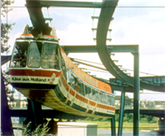 A
self-propelled vehicle speeds silently through the sky carrying 300
passengers. Riding high above congested freeway or gliding over rivers
and other impassable barriers, it is the last word in transit
technology. Called Aerobus, this proven system is economical to
install, environmentally friendly, and pollution-free.Site References: Installed in Australia, Canada, Germany, Switzerland, and the USA. A
self-propelled vehicle speeds silently through the sky carrying 300
passengers. Riding high above congested freeway or gliding over rivers
and other impassable barriers, it is the last word in transit
technology. Called Aerobus, this proven system is economical to
install, environmentally friendly, and pollution-free.Site References: Installed in Australia, Canada, Germany, Switzerland, and the USA. |
 |
Aeromovels123 |
 AEROMOVEL®
blowers propel air (under low pressure) through a duct built into the
guideway. The pressurized air pushes a propulsion plate attached to the
bottom of the vehicle. This propulsion plate acts like an upside down
sail, propelling the vehicle forward and helping to stop it when the
air flow is reversed.Site References: Installed and in operation in Brazil and Indonesia for more than 9 years. AEROMOVEL®
blowers propel air (under low pressure) through a duct built into the
guideway. The pressurized air pushes a propulsion plate attached to the
bottom of the vehicle. This propulsion plate acts like an upside down
sail, propelling the vehicle forward and helping to stop it when the
air flow is reversed.Site References: Installed and in operation in Brazil and Indonesia for more than 9 years. |
 |
Magplane12345 |
Magplanes
are high speed vehicles that can be boarded at conveniently located
magports which will enable passengers to commute short distances or
travel 400 km and more. A
Magplane System consists of an elevated aluminum guideway (magway)
through which independent magnetically levitated vehicles (Magplanes)
respond to "Dynamic Scheduling" to and from conveniently located
magports. "Dynamic Scheduling" enables Magplanes to be available to
passengers using real time analysis of ticket purchases. No passenger
will have to wait more than fifteen minutes and yet most trips will be
non-stop.Site References: Installed and in operation in Hong Kong since 2004. A
Magplane System consists of an elevated aluminum guideway (magway)
through which independent magnetically levitated vehicles (Magplanes)
respond to "Dynamic Scheduling" to and from conveniently located
magports. "Dynamic Scheduling" enables Magplanes to be available to
passengers using real time analysis of ticket purchases. No passenger
will have to wait more than fifteen minutes and yet most trips will be
non-stop.Site References: Installed and in operation in Hong Kong since 2004. |
 |
PRT1234567890 |
Personal
rapid transit is a generally unknown and undeveloped subset of a class
of transit systems known as Automated People Movers (APMs).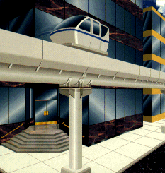 Typical APM (i.e., non-PRT) systems generally consist of vehicles
having capacities between 12 to 100 people which run along dedicated
guideways in a line-haul, fixed-schedule, configuration. Examples of
this type of system can be found in airport people-movers in U.S.
cities such as Seattle, Dallas-Ft. Worth and Miami. Although fairly
successful in these applications, APM systems have not been widely
accepted as realistic modes of urban transport for many reasons,
particulary with respect to PRT-type APMs. For PRT systems, some of
these reasons include inertia within traditional transit sectors to
consider new modes of transportation and inadequate testing of early
prototype systems which led to highly publicized failures (see History
of PRT). Furthermore, the definition of what comprises a PRT system has
been clouded over the past thirty years, a fact that has helped to
prevent serious research from being conducted in this area. In an
effort to standardize the terminology, the Advanced Transit Association
adopted in 1988 a set of guidelines that define a true PRT system.Site References: Tested extensively in Germany in early 1990's. Under construction in the UK and USA.
Typical APM (i.e., non-PRT) systems generally consist of vehicles
having capacities between 12 to 100 people which run along dedicated
guideways in a line-haul, fixed-schedule, configuration. Examples of
this type of system can be found in airport people-movers in U.S.
cities such as Seattle, Dallas-Ft. Worth and Miami. Although fairly
successful in these applications, APM systems have not been widely
accepted as realistic modes of urban transport for many reasons,
particulary with respect to PRT-type APMs. For PRT systems, some of
these reasons include inertia within traditional transit sectors to
consider new modes of transportation and inadequate testing of early
prototype systems which led to highly publicized failures (see History
of PRT). Furthermore, the definition of what comprises a PRT system has
been clouded over the past thirty years, a fact that has helped to
prevent serious research from being conducted in this area. In an
effort to standardize the terminology, the Advanced Transit Association
adopted in 1988 a set of guidelines that define a true PRT system.Site References: Tested extensively in Germany in early 1990's. Under construction in the UK and USA. |
 |
Skytran1234567 |
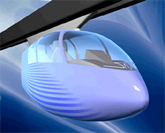 Personalized
vehicles: Two person vehicles with climate control, communication, web
access and entertainment options. Small portals: Conveniently located
every quarter mile. No massive stations or structures overwhelming the
local environment. Been referred to as the iPod of Personal Transport
System. Personalized
vehicles: Two person vehicles with climate control, communication, web
access and entertainment options. Small portals: Conveniently located
every quarter mile. No massive stations or structures overwhelming the
local environment. Been referred to as the iPod of Personal Transport
System. |
 |
SmartSkyway12 |
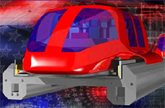 SmartSkyways
is a transit system of computer automated vehicles traveling on-demand
between stations on a network of elevated guideways. The guideway for
this six passenger configuration for a local loop is designed for
ten-thousand pound max weight and dynamic loading from fifty mph speeds.Site References: Feasibility study in progress in the USA. SmartSkyways
is a transit system of computer automated vehicles traveling on-demand
between stations on a network of elevated guideways. The guideway for
this six passenger configuration for a local loop is designed for
ten-thousand pound max weight and dynamic loading from fifty mph speeds.Site References: Feasibility study in progress in the USA. |
 |
STU12345678901 |
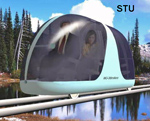 Several
unique aspects of the STU system result in a vehicle efficiency that is
far greater than cars, monorail, planes, trains or virtually any other
transport system. Firstly the steel wheel / track interface has been
developed to be twice as efficient as that of a train wheel (and 10
times better than a car wheel on a concrete road).Secondly, the
elevation above ground removes a major source of wind resistance (the
gap between a vehicle and the ground). Thirdly, the aerodynamics of the
vehicle have been refined to produce an incredibly low wind-drag
vehicle. To illustrate, a Porsche on the road has a wind-drag
coefficient of 0.26, whereas an elevated STU vehicle has a coefficient
of less than 0.1. Several
unique aspects of the STU system result in a vehicle efficiency that is
far greater than cars, monorail, planes, trains or virtually any other
transport system. Firstly the steel wheel / track interface has been
developed to be twice as efficient as that of a train wheel (and 10
times better than a car wheel on a concrete road).Secondly, the
elevation above ground removes a major source of wind resistance (the
gap between a vehicle and the ground). Thirdly, the aerodynamics of the
vehicle have been refined to produce an incredibly low wind-drag
vehicle. To illustrate, a Porsche on the road has a wind-drag
coefficient of 0.26, whereas an elevated STU vehicle has a coefficient
of less than 0.1. |
 |
System_211234 |
 Derived
from the technology's primary feature:2-direction traffic on 1 slender,
triangular "monobeam". The system is a major breakthrough which should
significantly influence the transit market in the 21st century.Site References: Feasibility study in progress in the USA. Derived
from the technology's primary feature:2-direction traffic on 1 slender,
triangular "monobeam". The system is a major breakthrough which should
significantly influence the transit market in the 21st century.Site References: Feasibility study in progress in the USA. |
 |
Urban_Maglev1 |
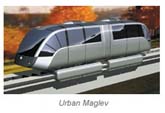 General
Atomics is developing Urban Maglev technology sponsored by the Federal
Transit Administration and funded under the Transportation Equity Act
for the 21st Century (TEA-21).The system is levitated, propelled, and
guided by electromagnetic forces. Levitation is achieved by using
simple, passive permanent magnets arranged in a “Halbach” array
configuration. Propulsion and guidance are achieved by a linear
synchronous motor mounted on the track. The uniqueness of the approach
is its simplicity, ruggedness, and performance. It is designed to
operate on a 7% grade, 50 meter (164 ft.) turn radius, and 25mm (1 in.)
levitation gap, and offers quiet operation.Site References: Feasibility study in progress in the USA. General
Atomics is developing Urban Maglev technology sponsored by the Federal
Transit Administration and funded under the Transportation Equity Act
for the 21st Century (TEA-21).The system is levitated, propelled, and
guided by electromagnetic forces. Levitation is achieved by using
simple, passive permanent magnets arranged in a “Halbach” array
configuration. Propulsion and guidance are achieved by a linear
synchronous motor mounted on the track. The uniqueness of the approach
is its simplicity, ruggedness, and performance. It is designed to
operate on a 7% grade, 50 meter (164 ft.) turn radius, and 25mm (1 in.)
levitation gap, and offers quiet operation.Site References: Feasibility study in progress in the USA. |
High Speed Bullet Train
Here is list of selected high speed bullet train technology available in the market place.
 |
ICE123456789012 |
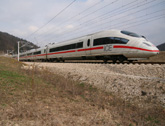 InterCity
Express, the "ICE" name is also used for the vehicles used on the
system, which were developed from the early 1980s in Germany and
specifically designed for the system. There are currently three
different versions of the ICE vehicles in use, named ICE 1 (deployed in
1991), ICE 2 (1996) and ICE 3 (1999). The ICE 3, including its variant
models, is made both by Bombardier and Siemens. Site References: Installed and in operation in Austria, Belgium, Denmark, France, Germany, Italy, the Netherlands, Russia, and Switzerland. InterCity
Express, the "ICE" name is also used for the vehicles used on the
system, which were developed from the early 1980s in Germany and
specifically designed for the system. There are currently three
different versions of the ICE vehicles in use, named ICE 1 (deployed in
1991), ICE 2 (1996) and ICE 3 (1999). The ICE 3, including its variant
models, is made both by Bombardier and Siemens. Site References: Installed and in operation in Austria, Belgium, Denmark, France, Germany, Italy, the Netherlands, Russia, and Switzerland. |
 |
JR_Maglev12345 |
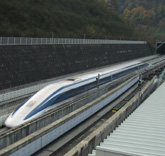 JR
Maglev is a magnetic levitation train system developed by the Central
Japan Railway Company and Railway Technical Research Institute
(association of Japan Railways Group). JR-Maglev MLX01 (X means
experimental) is one of the latest designs of a series of Maglev trains
in development in Japan since the 1970s. It is composed of a maximum 5
cars to run on the Yamanashi Maglev Test Line. On December 2, 2003, a
three-car train set attained a maximum speed of 581 km/h (361 mph)
(world speed record for railed vehicles) in a manned vehicle run. Site References: Installed and in operation in Japan. JR
Maglev is a magnetic levitation train system developed by the Central
Japan Railway Company and Railway Technical Research Institute
(association of Japan Railways Group). JR-Maglev MLX01 (X means
experimental) is one of the latest designs of a series of Maglev trains
in development in Japan since the 1970s. It is composed of a maximum 5
cars to run on the Yamanashi Maglev Test Line. On December 2, 2003, a
three-car train set attained a maximum speed of 581 km/h (361 mph)
(world speed record for railed vehicles) in a manned vehicle run. Site References: Installed and in operation in Japan. |
 |
KTX123456789012 |
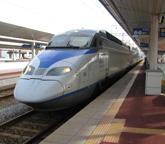 The
Korea Train eXpress (KTX) is South Korea's high-speed rail system. It
is operated by Korail. The train's technology is largely based on the
French TGV system, and has a top speed of 350 km/h, limited to 300 km/h
during regular service for safety. On December 16, 2004, the
Korean-made HSR-350x achieved an experimental top speed of 352.4
kilometers per hour. Site References: Installed and in operation in South Korea. The
Korea Train eXpress (KTX) is South Korea's high-speed rail system. It
is operated by Korail. The train's technology is largely based on the
French TGV system, and has a top speed of 350 km/h, limited to 300 km/h
during regular service for safety. On December 16, 2004, the
Korean-made HSR-350x achieved an experimental top speed of 352.4
kilometers per hour. Site References: Installed and in operation in South Korea. |
 |
Shinkansen12345 |
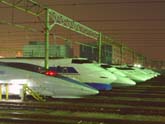 The
Shinkansen is a network of high-speed railway lines in Japan operated
by four Japan Railways Group companies. Since the initial Tōkaidō
Shinkansen opened in 1964 running at 210 km/h (130 mph), the network
(2,459 km or 1,528 miles) has expanded to link most major cities on the
islands of Honshū and Kyūshū with running speeds of up to 300 km/h (188
mph), in an earthquake and typhoon prone environment. Test run speeds
have been 443 km/h (275 mph) for conventional rail in 1996, and up to a
world record of 581 km/h (361 mph) for maglev trainsets, in
2003.Shinkansen literally means "New Trunk Line", referring to the
tracks, but the name is widely used in and outside Japan to refer to
the trains running on the lines as well as the system as a whole. The
name "Superexpress", initially used for Hikari trains, was officially
retired in 1972 but is still used in English-language. Site References: Installed and in operation in China, Japan, South Korea, Taiwan. The
Shinkansen is a network of high-speed railway lines in Japan operated
by four Japan Railways Group companies. Since the initial Tōkaidō
Shinkansen opened in 1964 running at 210 km/h (130 mph), the network
(2,459 km or 1,528 miles) has expanded to link most major cities on the
islands of Honshū and Kyūshū with running speeds of up to 300 km/h (188
mph), in an earthquake and typhoon prone environment. Test run speeds
have been 443 km/h (275 mph) for conventional rail in 1996, and up to a
world record of 581 km/h (361 mph) for maglev trainsets, in
2003.Shinkansen literally means "New Trunk Line", referring to the
tracks, but the name is widely used in and outside Japan to refer to
the trains running on the lines as well as the system as a whole. The
name "Superexpress", initially used for Hikari trains, was officially
retired in 1972 but is still used in English-language. Site References: Installed and in operation in China, Japan, South Korea, Taiwan. |
 |
TGV123456789012 |
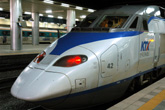 The
TGV (train à grande vitesse, French for "high-speed train") is France's
high-speed rail service developed by GEC-Alsthom (now Alstom) and SNCF,
the French national rail operator, and operated primarily by SNCF.
Following the inaugural TGV service between Paris and Lyon in 1981, the
TGV network, centred on Paris, has expanded to connect cities across
France and in adjacent countries. It holds the record for the fastest
wheeled train, having reached 574.8 km/h (357 mph) on 3 April 2007, and
also holds the world's highest average speed for a regular passenger
service. TGV is a registered trademark of SNCF. Site References: Installed and in operation in Belgium,
France, Germany, Italy, Korea (South), Spain, Switzerland and the UK.
Under construction in Morocco. Currently feasibility study is conducted
in Brazil. The
TGV (train à grande vitesse, French for "high-speed train") is France's
high-speed rail service developed by GEC-Alsthom (now Alstom) and SNCF,
the French national rail operator, and operated primarily by SNCF.
Following the inaugural TGV service between Paris and Lyon in 1981, the
TGV network, centred on Paris, has expanded to connect cities across
France and in adjacent countries. It holds the record for the fastest
wheeled train, having reached 574.8 km/h (357 mph) on 3 April 2007, and
also holds the world's highest average speed for a regular passenger
service. TGV is a registered trademark of SNCF. Site References: Installed and in operation in Belgium,
France, Germany, Italy, Korea (South), Spain, Switzerland and the UK.
Under construction in Morocco. Currently feasibility study is conducted
in Brazil. |
 |
Transrapid12345 |
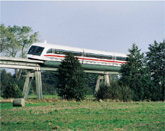 Transrapid
is a German high-speed monorail train using magnetic levitation. Based
on a patent from 1934, planning of the Transrapid system started in
1969. The system is developed and marketed by Transrapid International,
a joint venture of Siemens AG and ThyssenKrupp AG. The synchronous
longstator linear motor of the Transrapid maglev system is used both
for propulsion and braking. It functions like a rotating electric motor
whose stator is cut open and stretched lengthways along the underside
of the guideway. The superspeed maglev system has no wheels, axles,
transmissions, or pantographs. It does not roll, it hovers. Electronic
systems guarantee that the clearance remains constant (nominally 10
mm). The Transrapid car can use on-board backup batteries to power the
levitation system. Site References: Installed and in operation in Germany, under construction in China. Transrapid
is a German high-speed monorail train using magnetic levitation. Based
on a patent from 1934, planning of the Transrapid system started in
1969. The system is developed and marketed by Transrapid International,
a joint venture of Siemens AG and ThyssenKrupp AG. The synchronous
longstator linear motor of the Transrapid maglev system is used both
for propulsion and braking. It functions like a rotating electric motor
whose stator is cut open and stretched lengthways along the underside
of the guideway. The superspeed maglev system has no wheels, axles,
transmissions, or pantographs. It does not roll, it hovers. Electronic
systems guarantee that the clearance remains constant (nominally 10
mm). The Transrapid car can use on-board backup batteries to power the
levitation system. Site References: Installed and in operation in Germany, under construction in China. |
Innovative High Speed Train
Below are creative and unique prototype high speed train technology.
 |
Tubular12345678 |
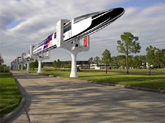 A unique concept and design of a high speed train from Tubuler, Inc. A unique concept and design of a high speed train from Tubuler, Inc. 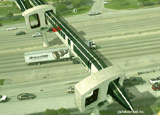 |

 |
CargoCap123456 |
CargoCap
is the fifth transportation alternative to the conventional systems of
road, rail, air and water. It is a safe and economical way to carry
goods quickly and on time in congested urban areas by underground
transportation pipelines. |
| 12345678901234567 |
CargoCap
develops working model on various types of underground freight
transport and/or capsule pipelines and related construction and
tunnelling technologies. The five specific objectives of CargoCap are: |
| 123456789012345678 |
- |
Review state-of-the-art and recent developments in the field of underground freight transport and/or capsule pipelines. |
|
- |
Share research findings among researchers. |
|
- |
Bring stakeholders together to plan for the future of these systems. |
|
- |
Bring attention to the capability of these systems as a sustainable new mode of freight transport for the future. |
|
- |
Organise
a worldwide network (coalition) to promote and accelerate commercial
use of underground freight transport and/or capsule pipelines. |
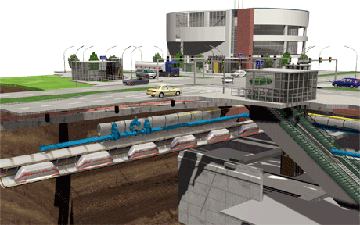
Hydrogen Train
Here is list of selected innovative rail technology available in the market place.
 |
East_Japan_Rail |
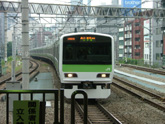 JR
East Japan Railway Company has successfully researched, developed and
tested a fuel cell system for railcars as an independent type motive
power system that reduces the burden on the global environment and can
also overcome the problem of exhaustion of fossil fuels. Based on these
results, the company is proceeding with the construction of the world's
first fuel cell hybrid railcar. This fuel cell hybrid railcar will be
realized by modifying the New Energy train (NE train) used for
development of a diesel engine-based hybrid system. Development of
railcar system technology that uses fuel cells is also being promoted
to utilize future breakthroughs in fuel cell technology. For latest
news on East Japan Railway's Hydrogen Train, click here to read (more). JR
East Japan Railway Company has successfully researched, developed and
tested a fuel cell system for railcars as an independent type motive
power system that reduces the burden on the global environment and can
also overcome the problem of exhaustion of fossil fuels. Based on these
results, the company is proceeding with the construction of the world's
first fuel cell hybrid railcar. This fuel cell hybrid railcar will be
realized by modifying the New Energy train (NE train) used for
development of a diesel engine-based hybrid system. Development of
railcar system technology that uses fuel cells is also being promoted
to utilize future breakthroughs in fuel cell technology. For latest
news on East Japan Railway's Hydrogen Train, click here to read (more). |
 |
VLTJ_Railway123 |
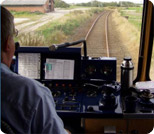 The
"Vemb-Lemvig-Thyborøn" Railway, or VLTJ Railway, will be the
demonstration and test line for "The Hydrogen Train". The line is
running through a mostly flat landscape with low train power
requirements, and therefore is ideal for testing a demonstration
hydrogen train. "The Hydrogen Train" is a European consortium aiming at
developing & launching Europe's first hydrogen powered train by
year 2010. For latest news on Vemb-Lemvig-Thyborøn Railway's Hydrogen
Train, click here to read (more). The
"Vemb-Lemvig-Thyborøn" Railway, or VLTJ Railway, will be the
demonstration and test line for "The Hydrogen Train". The line is
running through a mostly flat landscape with low train power
requirements, and therefore is ideal for testing a demonstration
hydrogen train. "The Hydrogen Train" is a European consortium aiming at
developing & launching Europe's first hydrogen powered train by
year 2010. For latest news on Vemb-Lemvig-Thyborøn Railway's Hydrogen
Train, click here to read (more). |
 A
self-propelled vehicle speeds silently through the sky carrying 300
passengers. Riding high above congested freeway or gliding over rivers
and other impassable barriers, it is the last word in transit
technology. Called Aerobus, this proven system is economical to
install, environmentally friendly, and pollution-free.Site References: Installed in Australia, Canada, Germany, Switzerland, and the USA.
A
self-propelled vehicle speeds silently through the sky carrying 300
passengers. Riding high above congested freeway or gliding over rivers
and other impassable barriers, it is the last word in transit
technology. Called Aerobus, this proven system is economical to
install, environmentally friendly, and pollution-free.Site References: Installed in Australia, Canada, Germany, Switzerland, and the USA. AEROMOVEL®
blowers propel air (under low pressure) through a duct built into the
guideway. The pressurized air pushes a propulsion plate attached to the
bottom of the vehicle. This propulsion plate acts like an upside down
sail, propelling the vehicle forward and helping to stop it when the
air flow is reversed.Site References: Installed and in operation in Brazil and Indonesia for more than 9 years.
AEROMOVEL®
blowers propel air (under low pressure) through a duct built into the
guideway. The pressurized air pushes a propulsion plate attached to the
bottom of the vehicle. This propulsion plate acts like an upside down
sail, propelling the vehicle forward and helping to stop it when the
air flow is reversed.Site References: Installed and in operation in Brazil and Indonesia for more than 9 years. A
Magplane System consists of an elevated aluminum guideway (magway)
through which independent magnetically levitated vehicles (Magplanes)
respond to "Dynamic Scheduling" to and from conveniently located
magports. "Dynamic Scheduling" enables Magplanes to be available to
passengers using real time analysis of ticket purchases. No passenger
will have to wait more than fifteen minutes and yet most trips will be
non-stop.Site References: Installed and in operation in Hong Kong since 2004.
A
Magplane System consists of an elevated aluminum guideway (magway)
through which independent magnetically levitated vehicles (Magplanes)
respond to "Dynamic Scheduling" to and from conveniently located
magports. "Dynamic Scheduling" enables Magplanes to be available to
passengers using real time analysis of ticket purchases. No passenger
will have to wait more than fifteen minutes and yet most trips will be
non-stop.Site References: Installed and in operation in Hong Kong since 2004. Typical APM (i.e., non-PRT) systems generally consist of vehicles
having capacities between 12 to 100 people which run along dedicated
guideways in a line-haul, fixed-schedule, configuration. Examples of
this type of system can be found in airport people-movers in U.S.
cities such as Seattle, Dallas-Ft. Worth and Miami. Although fairly
successful in these applications, APM systems have not been widely
accepted as realistic modes of urban transport for many reasons,
particulary with respect to PRT-type APMs. For PRT systems, some of
these reasons include inertia within traditional transit sectors to
consider new modes of transportation and inadequate testing of early
prototype systems which led to highly publicized failures (see History
of PRT). Furthermore, the definition of what comprises a PRT system has
been clouded over the past thirty years, a fact that has helped to
prevent serious research from being conducted in this area. In an
effort to standardize the terminology, the Advanced Transit Association
adopted in 1988 a set of guidelines that define a true PRT system.Site References: Tested extensively in Germany in early 1990's. Under construction in the UK and USA.
Typical APM (i.e., non-PRT) systems generally consist of vehicles
having capacities between 12 to 100 people which run along dedicated
guideways in a line-haul, fixed-schedule, configuration. Examples of
this type of system can be found in airport people-movers in U.S.
cities such as Seattle, Dallas-Ft. Worth and Miami. Although fairly
successful in these applications, APM systems have not been widely
accepted as realistic modes of urban transport for many reasons,
particulary with respect to PRT-type APMs. For PRT systems, some of
these reasons include inertia within traditional transit sectors to
consider new modes of transportation and inadequate testing of early
prototype systems which led to highly publicized failures (see History
of PRT). Furthermore, the definition of what comprises a PRT system has
been clouded over the past thirty years, a fact that has helped to
prevent serious research from being conducted in this area. In an
effort to standardize the terminology, the Advanced Transit Association
adopted in 1988 a set of guidelines that define a true PRT system.Site References: Tested extensively in Germany in early 1990's. Under construction in the UK and USA. Personalized
vehicles: Two person vehicles with climate control, communication, web
access and entertainment options. Small portals: Conveniently located
every quarter mile. No massive stations or structures overwhelming the
local environment. Been referred to as the iPod of Personal Transport
System.
Personalized
vehicles: Two person vehicles with climate control, communication, web
access and entertainment options. Small portals: Conveniently located
every quarter mile. No massive stations or structures overwhelming the
local environment. Been referred to as the iPod of Personal Transport
System. SmartSkyways
is a transit system of computer automated vehicles traveling on-demand
between stations on a network of elevated guideways. The guideway for
this six passenger configuration for a local loop is designed for
ten-thousand pound max weight and dynamic loading from fifty mph speeds.Site References: Feasibility study in progress in the USA.
SmartSkyways
is a transit system of computer automated vehicles traveling on-demand
between stations on a network of elevated guideways. The guideway for
this six passenger configuration for a local loop is designed for
ten-thousand pound max weight and dynamic loading from fifty mph speeds.Site References: Feasibility study in progress in the USA. Several
unique aspects of the STU system result in a vehicle efficiency that is
far greater than cars, monorail, planes, trains or virtually any other
transport system. Firstly the steel wheel / track interface has been
developed to be twice as efficient as that of a train wheel (and 10
times better than a car wheel on a concrete road).Secondly, the
elevation above ground removes a major source of wind resistance (the
gap between a vehicle and the ground). Thirdly, the aerodynamics of the
vehicle have been refined to produce an incredibly low wind-drag
vehicle. To illustrate, a Porsche on the road has a wind-drag
coefficient of 0.26, whereas an elevated STU vehicle has a coefficient
of less than 0.1.
Several
unique aspects of the STU system result in a vehicle efficiency that is
far greater than cars, monorail, planes, trains or virtually any other
transport system. Firstly the steel wheel / track interface has been
developed to be twice as efficient as that of a train wheel (and 10
times better than a car wheel on a concrete road).Secondly, the
elevation above ground removes a major source of wind resistance (the
gap between a vehicle and the ground). Thirdly, the aerodynamics of the
vehicle have been refined to produce an incredibly low wind-drag
vehicle. To illustrate, a Porsche on the road has a wind-drag
coefficient of 0.26, whereas an elevated STU vehicle has a coefficient
of less than 0.1. Derived
from the technology's primary feature:2-direction traffic on 1 slender,
triangular "monobeam". The system is a major breakthrough which should
significantly influence the transit market in the 21st century.Site References: Feasibility study in progress in the USA.
Derived
from the technology's primary feature:2-direction traffic on 1 slender,
triangular "monobeam". The system is a major breakthrough which should
significantly influence the transit market in the 21st century.Site References: Feasibility study in progress in the USA. General
Atomics is developing Urban Maglev technology sponsored by the Federal
Transit Administration and funded under the Transportation Equity Act
for the 21st Century (TEA-21).The system is levitated, propelled, and
guided by electromagnetic forces. Levitation is achieved by using
simple, passive permanent magnets arranged in a “Halbach” array
configuration. Propulsion and guidance are achieved by a linear
synchronous motor mounted on the track. The uniqueness of the approach
is its simplicity, ruggedness, and performance. It is designed to
operate on a 7% grade, 50 meter (164 ft.) turn radius, and 25mm (1 in.)
levitation gap, and offers quiet operation.Site References: Feasibility study in progress in the USA.
General
Atomics is developing Urban Maglev technology sponsored by the Federal
Transit Administration and funded under the Transportation Equity Act
for the 21st Century (TEA-21).The system is levitated, propelled, and
guided by electromagnetic forces. Levitation is achieved by using
simple, passive permanent magnets arranged in a “Halbach” array
configuration. Propulsion and guidance are achieved by a linear
synchronous motor mounted on the track. The uniqueness of the approach
is its simplicity, ruggedness, and performance. It is designed to
operate on a 7% grade, 50 meter (164 ft.) turn radius, and 25mm (1 in.)
levitation gap, and offers quiet operation.Site References: Feasibility study in progress in the USA. InterCity
Express, the "ICE" name is also used for the vehicles used on the
system, which were developed from the early 1980s in Germany and
specifically designed for the system. There are currently three
different versions of the ICE vehicles in use, named ICE 1 (deployed in
1991), ICE 2 (1996) and ICE 3 (1999). The ICE 3, including its variant
models, is made both by Bombardier and Siemens. Site References: Installed and in operation in Austria, Belgium, Denmark, France, Germany, Italy, the Netherlands, Russia, and Switzerland.
InterCity
Express, the "ICE" name is also used for the vehicles used on the
system, which were developed from the early 1980s in Germany and
specifically designed for the system. There are currently three
different versions of the ICE vehicles in use, named ICE 1 (deployed in
1991), ICE 2 (1996) and ICE 3 (1999). The ICE 3, including its variant
models, is made both by Bombardier and Siemens. Site References: Installed and in operation in Austria, Belgium, Denmark, France, Germany, Italy, the Netherlands, Russia, and Switzerland. JR
Maglev is a magnetic levitation train system developed by the Central
Japan Railway Company and Railway Technical Research Institute
(association of Japan Railways Group). JR-Maglev MLX01 (X means
experimental) is one of the latest designs of a series of Maglev trains
in development in Japan since the 1970s. It is composed of a maximum 5
cars to run on the Yamanashi Maglev Test Line. On December 2, 2003, a
three-car train set attained a maximum speed of 581 km/h (361 mph)
(world speed record for railed vehicles) in a manned vehicle run. Site References: Installed and in operation in Japan.
JR
Maglev is a magnetic levitation train system developed by the Central
Japan Railway Company and Railway Technical Research Institute
(association of Japan Railways Group). JR-Maglev MLX01 (X means
experimental) is one of the latest designs of a series of Maglev trains
in development in Japan since the 1970s. It is composed of a maximum 5
cars to run on the Yamanashi Maglev Test Line. On December 2, 2003, a
three-car train set attained a maximum speed of 581 km/h (361 mph)
(world speed record for railed vehicles) in a manned vehicle run. Site References: Installed and in operation in Japan. The
Korea Train eXpress (KTX) is South Korea's high-speed rail system. It
is operated by Korail. The train's technology is largely based on the
French TGV system, and has a top speed of 350 km/h, limited to 300 km/h
during regular service for safety. On December 16, 2004, the
Korean-made HSR-350x achieved an experimental top speed of 352.4
kilometers per hour. Site References: Installed and in operation in South Korea.
The
Korea Train eXpress (KTX) is South Korea's high-speed rail system. It
is operated by Korail. The train's technology is largely based on the
French TGV system, and has a top speed of 350 km/h, limited to 300 km/h
during regular service for safety. On December 16, 2004, the
Korean-made HSR-350x achieved an experimental top speed of 352.4
kilometers per hour. Site References: Installed and in operation in South Korea. The
Shinkansen is a network of high-speed railway lines in Japan operated
by four Japan Railways Group companies. Since the initial Tōkaidō
Shinkansen opened in 1964 running at 210 km/h (130 mph), the network
(2,459 km or 1,528 miles) has expanded to link most major cities on the
islands of Honshū and Kyūshū with running speeds of up to 300 km/h (188
mph), in an earthquake and typhoon prone environment. Test run speeds
have been 443 km/h (275 mph) for conventional rail in 1996, and up to a
world record of 581 km/h (361 mph) for maglev trainsets, in
2003.Shinkansen literally means "New Trunk Line", referring to the
tracks, but the name is widely used in and outside Japan to refer to
the trains running on the lines as well as the system as a whole. The
name "Superexpress", initially used for Hikari trains, was officially
retired in 1972 but is still used in English-language. Site References: Installed and in operation in China, Japan, South Korea, Taiwan.
The
Shinkansen is a network of high-speed railway lines in Japan operated
by four Japan Railways Group companies. Since the initial Tōkaidō
Shinkansen opened in 1964 running at 210 km/h (130 mph), the network
(2,459 km or 1,528 miles) has expanded to link most major cities on the
islands of Honshū and Kyūshū with running speeds of up to 300 km/h (188
mph), in an earthquake and typhoon prone environment. Test run speeds
have been 443 km/h (275 mph) for conventional rail in 1996, and up to a
world record of 581 km/h (361 mph) for maglev trainsets, in
2003.Shinkansen literally means "New Trunk Line", referring to the
tracks, but the name is widely used in and outside Japan to refer to
the trains running on the lines as well as the system as a whole. The
name "Superexpress", initially used for Hikari trains, was officially
retired in 1972 but is still used in English-language. Site References: Installed and in operation in China, Japan, South Korea, Taiwan. The
TGV (train à grande vitesse, French for "high-speed train") is France's
high-speed rail service developed by GEC-Alsthom (now Alstom) and SNCF,
the French national rail operator, and operated primarily by SNCF.
Following the inaugural TGV service between Paris and Lyon in 1981, the
TGV network, centred on Paris, has expanded to connect cities across
France and in adjacent countries. It holds the record for the fastest
wheeled train, having reached 574.8 km/h (357 mph) on 3 April 2007, and
also holds the world's highest average speed for a regular passenger
service. TGV is a registered trademark of SNCF. Site References: Installed and in operation in Belgium,
France, Germany, Italy, Korea (South), Spain, Switzerland and the UK.
Under construction in Morocco. Currently feasibility study is conducted
in Brazil.
The
TGV (train à grande vitesse, French for "high-speed train") is France's
high-speed rail service developed by GEC-Alsthom (now Alstom) and SNCF,
the French national rail operator, and operated primarily by SNCF.
Following the inaugural TGV service between Paris and Lyon in 1981, the
TGV network, centred on Paris, has expanded to connect cities across
France and in adjacent countries. It holds the record for the fastest
wheeled train, having reached 574.8 km/h (357 mph) on 3 April 2007, and
also holds the world's highest average speed for a regular passenger
service. TGV is a registered trademark of SNCF. Site References: Installed and in operation in Belgium,
France, Germany, Italy, Korea (South), Spain, Switzerland and the UK.
Under construction in Morocco. Currently feasibility study is conducted
in Brazil. Transrapid
is a German high-speed monorail train using magnetic levitation. Based
on a patent from 1934, planning of the Transrapid system started in
1969. The system is developed and marketed by Transrapid International,
a joint venture of Siemens AG and ThyssenKrupp AG. The synchronous
longstator linear motor of the Transrapid maglev system is used both
for propulsion and braking. It functions like a rotating electric motor
whose stator is cut open and stretched lengthways along the underside
of the guideway. The superspeed maglev system has no wheels, axles,
transmissions, or pantographs. It does not roll, it hovers. Electronic
systems guarantee that the clearance remains constant (nominally 10
mm). The Transrapid car can use on-board backup batteries to power the
levitation system. Site References: Installed and in operation in Germany, under construction in China.
Transrapid
is a German high-speed monorail train using magnetic levitation. Based
on a patent from 1934, planning of the Transrapid system started in
1969. The system is developed and marketed by Transrapid International,
a joint venture of Siemens AG and ThyssenKrupp AG. The synchronous
longstator linear motor of the Transrapid maglev system is used both
for propulsion and braking. It functions like a rotating electric motor
whose stator is cut open and stretched lengthways along the underside
of the guideway. The superspeed maglev system has no wheels, axles,
transmissions, or pantographs. It does not roll, it hovers. Electronic
systems guarantee that the clearance remains constant (nominally 10
mm). The Transrapid car can use on-board backup batteries to power the
levitation system. Site References: Installed and in operation in Germany, under construction in China. A unique concept and design of a high speed train from Tubuler, Inc.
A unique concept and design of a high speed train from Tubuler, Inc. 


 JR
East Japan Railway Company has successfully researched, developed and
tested a fuel cell system for railcars as an independent type motive
power system that reduces the burden on the global environment and can
also overcome the problem of exhaustion of fossil fuels. Based on these
results, the company is proceeding with the construction of the world's
first fuel cell hybrid railcar. This fuel cell hybrid railcar will be
realized by modifying the New Energy train (NE train) used for
development of a diesel engine-based hybrid system. Development of
railcar system technology that uses fuel cells is also being promoted
to utilize future breakthroughs in fuel cell technology. For latest
news on East Japan Railway's Hydrogen Train, click here to read (more).
JR
East Japan Railway Company has successfully researched, developed and
tested a fuel cell system for railcars as an independent type motive
power system that reduces the burden on the global environment and can
also overcome the problem of exhaustion of fossil fuels. Based on these
results, the company is proceeding with the construction of the world's
first fuel cell hybrid railcar. This fuel cell hybrid railcar will be
realized by modifying the New Energy train (NE train) used for
development of a diesel engine-based hybrid system. Development of
railcar system technology that uses fuel cells is also being promoted
to utilize future breakthroughs in fuel cell technology. For latest
news on East Japan Railway's Hydrogen Train, click here to read (more). The
"Vemb-Lemvig-Thyborøn" Railway, or VLTJ Railway, will be the
demonstration and test line for "The Hydrogen Train". The line is
running through a mostly flat landscape with low train power
requirements, and therefore is ideal for testing a demonstration
hydrogen train. "The Hydrogen Train" is a European consortium aiming at
developing & launching Europe's first hydrogen powered train by
year 2010. For latest news on Vemb-Lemvig-Thyborøn Railway's Hydrogen
Train, click here to read (more).
The
"Vemb-Lemvig-Thyborøn" Railway, or VLTJ Railway, will be the
demonstration and test line for "The Hydrogen Train". The line is
running through a mostly flat landscape with low train power
requirements, and therefore is ideal for testing a demonstration
hydrogen train. "The Hydrogen Train" is a European consortium aiming at
developing & launching Europe's first hydrogen powered train by
year 2010. For latest news on Vemb-Lemvig-Thyborøn Railway's Hydrogen
Train, click here to read (more).